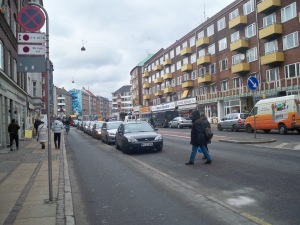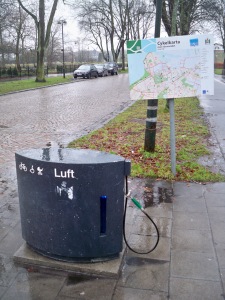I think the bicycle infrastructure in Copenhagen must be the best example of “If you build it, they will come.” 
I did some research since we got back, and discovered that Copenhagen, despite the boom in bike riding during war-time gasoline rationing, had succumbed to the lure of the automobile, and had become “car-clogged” by the 1960s. The energy crisis and recession in the 70s led to a resurgence in alternate means of transportation, and after massive demonstrations demanding better bicycle infrastructure, the government began to install bike lanes and more. (Info from the Copenhagen Cycling Embassy) Can you imagine that? Demonstrations demanding the government improve cycling! When do we start?!
Here are some of those famous bicycle infrastructure investments, now paid off a million times over.
Completely separate bicycle lanes. Not only are the bike lanes wide enough for cyclists to pass each other, they are raised above the street level, separated with stone, and right next to the sidewalk (which is then higher than the bike lane). Parking spots were then in between the lanes and the streets, lessening the chance that a car will pull out in front of you unexpectedly.
The bus stops are on the sidewalk, and the bus stops outside the bike lane. People step off into the bike lane, which would be problematic here, but in Copenhagen, people on bikes stop or slow down for passengers getting on or off the bus. It’s not a big deal, they just do it.
Bike lanes are painted blue through intersections or questionable lane changes. Through many intersections, the blue lanes also had bicycle symbols painted the entire way, so it was clear to drivers that it was a bike lane.
Bicycles had their own left turn lanes in many intersections, as well as their own stop lights. They also had their own right turn lanes.

Where the bicycle lane turned into right turn lanes, they were marked to show that both were permitted, with the blue lane continuing through the intersection.
The day it snowed, we were dumbfounded to emerge from our tasty Nimb Brasserie lunch to discover that the bike lane had been cleared before the street! And there were people out on bikes in the snow, too, although I couldn’t get a good picture of them. (Side note – the snow plows were fairly small, not the ginormous ones you find here, perfect size for a bike lane.)
There were bike racks everywhere! Many large stores had between 25-50 spots for bicycles in front of them, plus there were racks in open spaces, and if those were full, the bikes were just locked in somewhat orderly rows (you can do this when you use ring locks). There were also several different types of racks.



Grocery stores had bike parts! You could buy sets of lights, pumps, reflective tape, repair kits, and even sets of tire levers, along with your yogurt, cereal, veggies and wine. We went into a huge supermarket in Malmo, Sweden, with a larger bike section than automotive section! There we found tires, inner tubes, reflectors, reflective vests, and more. Boy was that a fun stop!


Malmo had slightly different lanes and bicycle stop lights, and they also had a huge city bike map posted next to an air hose. The air hose was marked for bicycles, wheelchairs, and baby buggies – as in Copenhagen, everything that was bicycle-friendly was also wheelchair and baby buggy friendly. We need that sort of focus here: what is good for bicycles is good for all.
We were excited to get to bike past the bike counter ourselves one day. When we went by around 11am, the counter read 8211 for the day so far, then when we passed it on our way home that night, it read over 11,000. 
I’ve seen so many pictures of the footrests for cyclists and it was cool to be able to use it myself, although pushing off from it was challenging. Or maybe that was the coaster brakes giving me problems again.

The Green Wave is where certain roads have had the green lights timed just perfectly so that you can bike along at about 12mph and hit a green light at every intersection. It’s in effect during rush hours, so you can make it across the city faster. Sometimes I feel as if I’ve hit every red light the entire way to work, so I’d love this option!
The Green Cycle Routes are somewhat similar to the Green Wave but more relaxed. They are basically bike lanes that cross the city removed from the main roads. When we rode it (in pouring rain), it felt like being in a park. I’m sure that when the weekends are nice, it’s packed with families.
All the S-tog stations had tons of bike racks, some that were double-decker bike racks. I did see some bikes with yellow tape around the back fender and tire – I assume they were tagging potentially abandoned bikes. We did see many abandoned bikes, in varying states of destruction, which made me sad.

We only came across this in one location, but it was where we needed it, so we were very grateful – rails to push your bike up the stairs (or down). I’d love to see these everywhere. 
As you can see, the city has gone far beyond just painting a few bike lanes. This would be why people bike 1.2 million kilometers every day in Copenhagen. According to the City, 37% are commuting to school or work. If our cities could be even half this bike-friendly, maybe we could slowly approach that number here as well.
Hey, a girl can dream!
See also:

Wow that’s great info. I live here but I haven’t noticed many of the above!